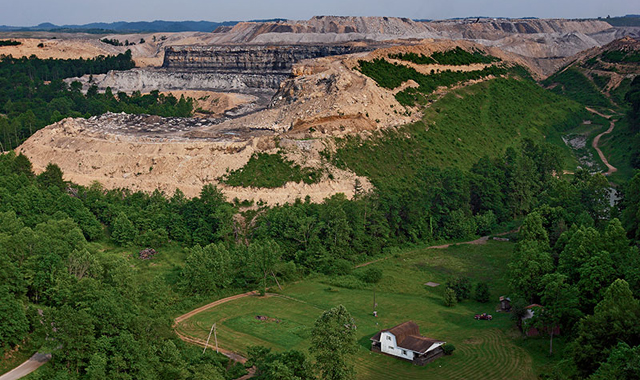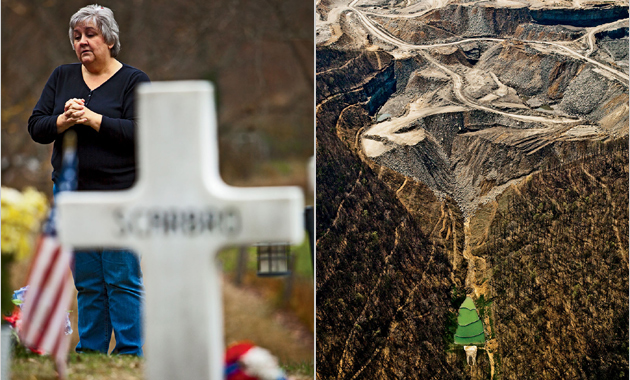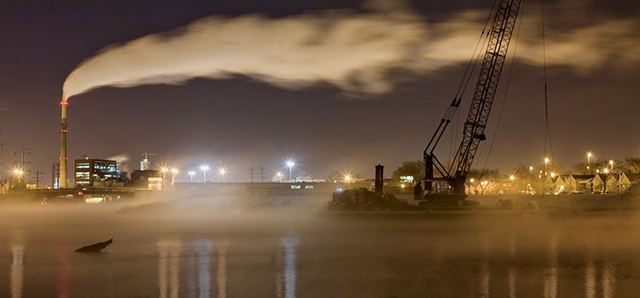sierraclub.org - sierra magazine - july/august 2010 - close to home


Close to Home
Even the coal industry's best friends are giving it the bad news: Demand is declining, reserves are vanishing, mountaintop removal is unacceptable, and emissions must be reduced. Slowly, surely, the United States is moving past coal.
By Jeff Biggers

The Hobet 21 mine outside Mud, West Virginia.
Charting the Green Jobs | Best & Worst States | Map: Coal vs. Clean Energy
It was April 1 in West Virginia, and blossoms already dotted Lorelei Scarbro's heirloom apple and plum orchards. But the buzz of pollination was muffled by the rumble of bulldozers from the nearby Bee Tree strip mine on Coal River Mountain. Drowning out both was the day's historic proclamation from the Environmental Protection Agency, the result of an extra-ordinary, decade-long campaign by coalfield residents and citizens' groups. The EPA's "guidance" sharply raises the environmental standards that future mountaintop-removal coal mines will be held to—including the impending 6,000-acre operation on Scarbro's property line.
"This is the beginning of the end for valley fills and mountaintop removal," said Scarbro, a community organizer for Coal River Mountain Watch in Whitesville. "We are not leaving our mountains."
The mountains, however, have been leaving West Virginia. In the coal industry's rush to mine more cheaply, quickly, and mechanically, more than 500 mountains and 1.2 million acres of ancient hardwood forests have been blown to bits. The tops of the mountains are blasted off to get at the coal below, and the waste is dumped into adjacent valleys and hollows, leaving thousands of miles of streams and waterways jammed with toxic waste.

In a family cemetery on her property, Lorelei Scarbro stands by the grave of her husband, Kenneth, who died of black lung disease (right). A settlement pond in a valley filled with mining debris in southern West Virginia (left).
But this spring, citing new science that conclusively proves the commonsense proposition that "burial of headwater streams by valley fills causes permanent loss of ecosystems," EPA administrator Lisa Jackson stunned both coalfield residents and the coal industry by invoking the Clean Water Act to issue stringent new guidelines limiting the amount of dissolved solids allowable in waterways. The agency also acknowledged, for the first time, the health hazards for those living near such operations. "No or very few valley fills are going to be able to meet standards like this," Jackson declared. In fact, her ruling grants protection to 95 percent of the freshwater streams in central Appalachia.
 Coal River Valley activist Bo Webb being arrested at a protest against mountaintop-removal mining on June 23, 2009 (above). Some of the 500 Chicagoans demanding the shutdown of the coal-powered Fisk Generating Station (below).
Coal River Valley activist Bo Webb being arrested at a protest against mountaintop-removal mining on June 23, 2009 (above). Some of the 500 Chicagoans demanding the shutdown of the coal-powered Fisk Generating Station (below).Big changes are coming to coal country—and to the country at large, which still relies on coal for nearly half of its energy needs. Coal jobs continue to plummet. More states are turning to alternative energy sources; wind power increased by 39 percent last year, even during the recession. The number of new coal-fired power plants being built has been reduced to a trickle. And the nation is inching toward putting a price on carbon emissions as a way to slow climate change.
The coal industry is not taking it well. A day after Jackson's announcement, the public relations group Friends of Coal charged that the EPA had "mobilized a new war on West Virginia coal." The Federation for American Coal, Energy and Security (FACES), another coal industry PR front, called the EPA's ruling "as dangerous and threatening an action as this region has ever seen."
Those sentiments are echoed in inflammatory rhetoric in the coalfields. At a pro-coal rally in Charleston, West Virginia, last fall, a speaker referred to the EPA as a "modern-day Gestapo."
A week later, a representative of a heavy-equipment distributor was quoted comparing nonviolent anti-mountaintop-removal protesters to "suicide bombers." FACES ran ads depicting coal protesters as masked bandits, with the slogan "If they win, we lose." Public hearings in West Virginia called by the Army Corps of Engineers last October turned into bedlam when thousands of coal supporters shouted down and threatened residents who sought to testify against mountaintop removal.
But yelling can't drown out the bad news for coal, which even the industry's allies are bearing. Late last year, coal's best friend in Congress over the past half century, West Virginia's 92-year-old Senator Robert Byrd, declared it was time for "an open and honest dialogue about coal's future." Jobs were going away, he said—not because of the EPA, but because of mechanization and declining energy demand. As for mountaintop removal, Byrd said, "most members of Congress, like most Americans, oppose the practice, and we may not yet fully understand the effects of mountaintop-removal mining on the health of our citizens."
Big Coal's greatest threats, Byrd said, "do not come from possible constraints on mountaintop- removal mining or other environmental regulations, but rather from rigid mindsets, depleting coal reserves, and the declining demand for coal as more power plants begin shifting to biomass and natural gas as a way to reduce emissions."

Chicago's Fisk Generating Station was built before the invention of the Model T. As a "legacy" plant, it is exempt from Clean Air Act emission standards.
Byrd cautioned coal's opponents as well: "No deliberate effort to do away with the coal industry could ever succeed in Washington," he said, "because there is no available alternative energy supply that could immediately supplant the use of coal for base-load power generation in America." And indeed, the EPA's Jackson noted that her move stopped short of the complete ban on mountaintop-removal mining that many coalfield residents and their supporters wanted. "This is not about ending coal mining," she insisted. "This is about ending coal mining pollution."
The end of mountaintop removal would affect less than 10 percent of national coal production, and only that in West Virginia, Tennessee, southwestern Virginia, and Kentucky. Most coal comes from stripmining (of which mountaintop removal is an extreme subset). Stripmining takes place in 24 states and on several Native American reservations. The largest strip mine in the eastern states will open later this year in Indiana, with another planned for the pristine Otter Creek Valley in eastern Montana. (See "High Plains Poison," March/April.) A day after the EPA announced its mountaintop guidelines, the Bureau of Land Management OK'd the expansion of one of the largest strip mines in the nation, Cloud Peak Energy's Antelope Mine, in Wyoming's Powder River Basin. The company expects the mine to yield a total of 430 million tons of coal—nearly three times West Virginia's annual production.
My own relationship with coal began at Eagle Creek, in the Shawnee Hills of southern Illinois. In 1999, the eighth generation of my family to live there was forced out by stripmining operations. Our 150-year-old log cabin and historic 200-year-old settlement, on the boundary of a federally protected wilderness area, were destroyed. This family tragedy set me off on a 10-year journey to examine coal's human and environmental costs.
Above all, I learned that we are repeating the injustices and errors of the past, precisely because we have forgotten this history. In his classic 1963 book Night Comes to the Cumberlands, Harry Caudill wrote that "the rape of Appalachia got its practice" in Illinois. Commercial stripmining in the state dates to the 1850s. I came to see stripmining as a reminder of the denial of the real costs of coal in every generation, including our own. Although black lung disease was first diagnosed in 1831, it took until 1969—as my coal miner and black lung-afflicted grandfather reminded me—for the federal government to pass legislation to deal with its ravages. And while scientists recognized the harmful impact of sulfur dioxide emissions as early as the 1860s, it took an aggressive grassroots movement to pass the Clean Air Act of 1990 to overcome the denial of acid rain's existence.
Illinois is also where Barack Obama's relationship with coal began. His first visit to the coalfields took place in the southern part of the state in 1997, on a golf outing with a fellow state legislator. Obama soon began to invoke the motto of the state mining industry, describing Illinois as the "Saudi Arabia of coal."
(Obama's own Chicago ranks high among U.S. cities adversely affected by power-plant pollution. Much of it comes from the decrepit Crawford Power Plant and the Fisk Generating Station, built before the invention of the Model T. Together, they shower thousands of tons of toxic mercury, nitrogen oxides, sulfur, soot, and particulate matter on the Windy City.)
When Obama became president, the coal industry began working overtime to play to his coal-state instincts. Since 2008, the American Coalition for Clean Coal Electricity has spent an estimated $120 million on a slick, upbeat PR campaign aimed at cementing coal's place in U.S. energy policy. On the one hand, the group attacks climate-change legislation; on the other, it supports increased subsidies for efforts to address coal's role in climate change through carbon capture and storage (CCS) technology—capturing CO2 when coal is burned and sequestering it far underground.
Setting aside the question of potential leaks, the process appears to be prohibitively expensive. Harvard University's Belfer Center said that running a coal plant with a CCS system would require at least 30 percent more fuel to produce the same amount of energy. Even so, CCS projects won nearly $4 billion in federal stimulus funds, including more than $1 billion for FutureGen, the nation's first CCS project in Mattoon, Illinois. Obama established a task force with the mandate to speed the development of 5 to 10 commercial demonstrations of CCS by 2016. This April, responding to complaints by a panel of coal executives that Washington had declared a "war on coal," Representative Jay Inslee reminded them that the Waxman-Markey energy bill includes $60 billion in subsidies for CCS and other cleaner coal technologies. "We don't give $60 billion to industries we are at war with," Inslee said.
The Project That Obama and Congress are signing on to—and Big Coal's major hope for the future—is the chimerical notion of "clean coal." That phrase has been an industry marketing slogan for more than a century, dating back to the 1890s, when Francis Peabody, of Peabody Energy, peddled supposedly smoke-free coal to burn in stoves and furnaces. It was revived in 1992 when the National Coal Council held a conference to improve coal's "dismal image." To the extent that Americans thought about coal, they thought of air pollution, mine safety, unregulated stripmining, and acid rain. Coal was destined to play the villain unless "effective actions [were] taken to alter the public's perception of coal." Thus "clean coal" was reborn.
In the wake of Dick Cheney's Energy Task Force, said Becki Clayborn, a Sierra Club representative in Chicago, "pulverized coal" was the technology du jour. "First was the rush of pulverized-coal plant proposals in Illinois—17 proposals at one point in time," she recalled. "The Sierra Club in Illinois was successful at halting all but two, through a combination of permit challenges and grassroots organizing." As an unforeseen result of those successes, Illinois became the leader in promoting a "clean coal" technology called "coal gasification," through state grants, legislative subsidies, and state bonds. The subsidies, Clayborn noted, require that the pilot plants use Illinois Basin coal, which is increasingly obtained through the highly mechanized, destructive technique known as "long-wall mining," wherein supporting pillars of coal are removed along with the coal seam, collapsing the overlying rock.
When this happens, the prime farmland on the surface also drops, often by more than five feet, disrupting aquifers and turning prized level fields into rutted swamps. Illinois's Citizens Against Longwall Mining, a coalition of farmers, environmental groups, and others, estimates that agricultural productivity drops by up to 95 percent in long-wall-mined areas, forcing multigenerational farm families to move.
For all the industry's talk about the impending cleanliness of coal, here's what happened during the hour and nine minutes it took Obama to deliver his 2010 State of the Union address: Power plants in 48 states burned 137,000 tons of coal, releasing more than a quarter million tons of CO2 and 12 pounds of toxic mercury. As we watched the president on our televisions, arsenic from coal ash, along with boron, selenium, and lead, continued to seep into our watersheds. The American Lung Association estimates that in that time three Americans died prematurely because of illnesses related to coal-fired-power-plant pollution. An estimated three coal miners died that day from black lung disease.
Six years ago, the Sierra Club's Beyond Coal campaign decided "to leave no new coal plant unopposed" and began working with dozens of organizations to build a nationwide movement that would, in the words of then-campaign director Bruce Nilles, "loosen the coal industry's lock on our future and our politics." Since then, 127 proposed coal-fired power plants have been abandoned, disallowed, or otherwise canceled.
A case in point is Blackstone Energy subsidiary Sithe Global, which had planned to build three new coal-fired power plants. This spring, the one in Pennsylvania was canceled; the one on the Navajo Nation in New Mexico was denied permits and seems unlikely to proceed; and the one in Mesquite, Nevada, was revamped into a combination natural-gas and photovoltaic-solar plant that will emit 60 percent less carbon dioxide and consume 60 percent less water than a coal-fired plant. All of a sudden, Mesquite mayor Susan Holecheck said, her town "has a future."
Appalachia's future may be improved by the EPA's new guidelines on mountaintop-removal mining, but the bulldozers are still rumbling beyond Lorelei Scarbro's orchard. The protections for stream quality apply only to new projects. "The 2,000-acre strip site above my home is blasting and dumping as usual," reported longtime Coal River Valley activist Bo Webb from his home in Peachtree, West Virginia, hours after the EPA announcement. "What about the hundreds of thousands of acres of active mountaintop-removal sites that are poisoning our streams and communities right now?"
Although he is not benefiting directly from the ruling, Webb helped to bring it about. For years he has worked closely with Scarbro and others to draw attention to the mountaintop-removal issue, seldom more successfully than last summer, when he organized a protest in the Coal River Valley that resulted in the arrests of NASA climatologist James Hansen, actress Daryl Hannah, and future Sierra Club executive director Michael Brune, among others.
Like Webb, Stephanie Pistello worries that the coal industry will find a way around the new EPA rules. A coal miner's granddaughter from Virginia and the national field coordinator of Appalachian Voices, she helped bring 250 people, half of them coalfield residents, to lobby Congress in favor of the Clean Water Protection Act, which would permanently end the dumping of coal-mining waste into valleys and waterways.
"The 40-year rap sheet of the coal industry's violations and its ability to slip through the regulatory loopholes have taught us one important history lesson," said Pistello. "Mountaintop removal cannot be regulated. It must be abolished."
As early as 1892, a Chicago Tribune editorial questioned the wisdom of relying on coal: "Doubtless the end of the coal, at least as an article of a mighty commerce, will arrive within a period brief in comparison with the ages of human existence." The editorial lambasted Americans for their unwillingness to conserve energy and their need to "invent appliances to exhaust with ever greater rapidity the hoard of coal."
"How long can the earth sustain life," it asked, if we depend on the "wonderful power of coal?" More than a century later, it's come to this: "Coal is the single greatest threat to civilization and all life on our planet," climatologist Hansen said. "Our global climate is nearing tipping points." So, at last, is the future of coal.
Jeff Biggers is the author of Reckoning at Eagle Creek: The Secret Legacy of Coal in the Heartland (Nation Books), among other books. He is a cofounder of Coal Free Future.
This article was funded by the Sierra Club's Beyond Coal campaign. For a complete collection of Sierra's coal coverage, see sierraclub.org/sierra/coal.
ON THE WEB Watch a trailer for Jeff Biggers's Reckoning at Eagle Creek. Appalachian Voices does a virtual flyover of Virginia mountaintop-removal sites.
Photos, from top: Melissa Farlow, Paul Corbit Brown (3), Matt Leonard, David Schalliol